A proposal timeline is often the backbone of early project planning, guiding teams from concept to decision with a clear sequence of actions. In many organizations, this framework is used internally to align leadership, secure resources and anticipate challenges before work begins.
Without it, even well-developed ideas can lose momentum before approval. By organizing steps in a logical order, the timeline helps stakeholders stay focused on what needs to happen and when, ensuring a smoother path toward project launch.
For most teams, the timeline for project proposal planning is an internal roadmap for discussions, reviews and final sign-off. Using a project proposal timeline example makes it easier to visualize each stage, from initial drafting to approval.
This structured timeline in project proposal work reduces confusion, improves collaboration and prevents critical steps from being missed. By following a defined project proposal timeline, organizations can make informed decisions faster and start projects on a solid foundation.
What Is a Project Proposal Timeline?
A project proposal timeline is a structured schedule that outlines the key steps and milestones involved in getting a project proposal reviewed and approved. It helps teams map out the order of activities, such as drafting, stakeholder review and revisions, along with the deadlines for each stage. This ensures that everyone involved understands their responsibilities and can work toward a shared goal within a defined timeframe.
The timeline for project proposal planning is particularly valuable in internal settings where multiple departments must coordinate input before a decision is made. By using a project proposal timeline example, teams can anticipate potential bottlenecks, allocate time for feedback and confirm that every requirement is addressed. This structured timeline in project proposal efforts allows organizations to be more efficient, make better-informed choices and start projects with stronger alignment among stakeholders.
Once a project proposal is approved, project management software helps transform the timeline into a living plan. These tools allow teams to set tasks, assign responsibilities, track progress and monitor resources in real time. This ensures that the momentum from the proposal stage carries forward into execution without losing critical details.
ProjectManager, an award-winning project and portfolio management software, has Gantt charts that turn a project proposal timeline into an actionable plan by linking each task with all four types of task dependencies to avoid cost overruns, deadlines and progress tracking in real time by setting a baseline.
Teams can visualize the workflow, identify potential delays and adjust schedules instantly, even filter for the critical path to identify tasks with zero slack. This makes it easier to transition from planning to doing while keeping everyone on the same page. Get started with ProjectManager today for free.
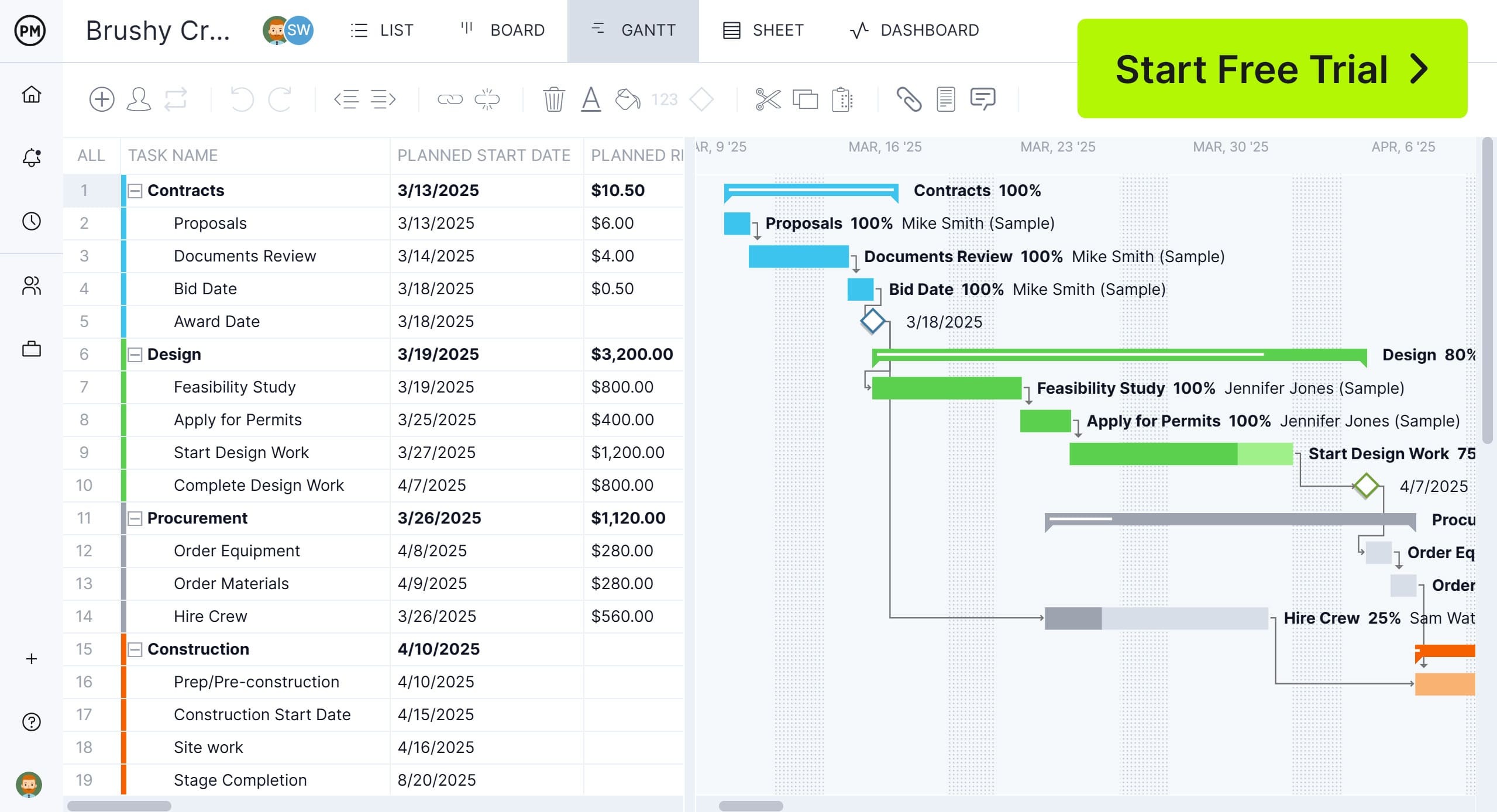
Project Proposal Timeline Explained
A project proposal is a formal document used to outline the purpose, scope and expected outcomes of a proposed initiative. It serves as a persuasive tool to secure approval, resources and stakeholder alignment before work begins.
By presenting objectives, timelines and potential benefits, a project proposal helps decision-makers understand the value of the project and why it should move forward. Below are the components.
1. Identification of Business Need or Problem
Identification of a business need or problem is the first step toward justifying a new project or initiative. It involves analyzing current operations, pinpointing gaps or inefficiencies and recognizing opportunities for improvement. Clearly defining the issue sets the foundation for proposing effective solutions and gaining stakeholder support. This is done using the following.
- Business Case: A formal document that outlines the rationale for the project, including expected benefits, costs, risks, and strategic alignment. It serves as the primary justification for project initiation.
- Needs Assessment: An analysis to determine the gap between current and desired conditions. It helps define the problem, affected stakeholders and urgency for action.
- Project Background Document: Provides historical context, previous attempts, lessons learned, and relevant organizational initiatives. Useful for reviewers unfamiliar with the problem space.
- Problem Statement: A concise description of the issue the project seeks to resolve. It should be specific, measurable, and linked to business objectives.
- Opportunity Analysis: If the proposal is driven by a market opportunity rather than a problem, this outlines competitive advantage, timing and potential gains.
2. Proposal Feasibility Study
A proposal feasibility study tests whether an idea can move from concept to approval with confidence. Before investing time and resources, teams validate the case from multiple angles to confirm the solution is viable, desirable and achievable.
By assessing economics, technology, operations, legal context, market fit, schedule and strategic alignment, you reduce risk and build a stronger narrative for stakeholders. The result is a clear yes or no decision that informs your proposal timeline and guides next steps.
Economic Feasibility
Economic feasibility evaluates whether expected benefits outweigh costs over the project’s life cycle. Build a simple financial model that captures capital expenses, operating costs and potential savings or revenue. Include assumptions for adoption, utilization and price sensitivity.
Compare outcomes using net present value, payback period and return on investment to judge attractiveness. Test downside and upside scenarios to expose risk. If results remain positive across reasonable ranges, the economics support moving forward and strengthen the case in your proposal timeline.
Technical Feasibility
Technical feasibility examines whether the required technology exists, integrates with current systems and can be supported by your team. Map core capabilities to solution requirements, noting gaps that demand new tools or custom development. Validate performance, scalability and security against target workloads.
Assess vendor maturity and roadmap stability. Plan for data migration and interfaces with key platforms. If the stack meets requirements with manageable risk, you can proceed knowing the solution can be built and maintained without undue complexity.
Operational Feasibility
Operational feasibility asks whether people, processes and facilities can sustain the solution day to day. Identify roles, training needs and support procedures required for launch, then steady state. Document changes to workflows and handoffs across departments.
Estimate capacity impacts on service desks and back office teams. Confirm that standard operating procedures, runbooks and KPIs can be established quickly. When frontline staff can adopt the solution with clear guidance and reasonable effort, operational feasibility is credible and adoption risk decreases.
Legal and Regulatory Feasibility
Legal and regulatory feasibility confirms compliance with laws, contracts and industry standards. Review data privacy, retention and residency obligations. Check licensing, accessibility and cybersecurity requirements relevant to your jurisdiction. Validate that vendor terms align with procurement policy and audit needs.
Engage counsel early to flag restrictions or approval gates that could affect the timeline. If obligations are clear and controls are practical to implement, the legal path is sound and your proposal can advance with fewer approval surprises.
Market Feasibility
Market feasibility determines whether stakeholders will value and adopt the outcome. For internal initiatives, treat business units as your market. Validate pain points, willingness to change and expected usage through interviews and small pilots.
For external offerings, size demand, analyze competitor positioning and define differentiation. Estimate adoption curves and sensitivities that shape benefits. If evidence shows a meaningful problem, a clear solution and credible pathways to engagement, market feasibility supports the investment case and future scaling.
Schedule Feasibility
Schedule feasibility tests whether objectives can be met within the available time. Build a high-level plan with milestones, dependencies and critical path. Identify resource constraints, seasonal factors and change freezes that affect timing. Include lead times for procurement, legal review and integration testing.
Add buffers for learning and risk. If the plan reaches the desired launch window with acceptable contingency, schedule risk is manageable and leadership can commit with greater confidence in delivery dates.
Strategic Alignment
Strategic alignment confirms the proposal advances corporate goals and portfolio priorities. Map outcomes to strategy pillars such as growth, efficiency, risk reduction or customer experience. Show how metrics will move and which initiatives this work enables or de-risks. Check fit with architectural principles and talent strategy.
If the project supports high-priority objectives, complements adjacent efforts and avoids conflicts, alignment is strong. This validation helps secure sponsorship and protects the proposal as competing requests vie for funding.
3. Development of Proposal Document
The development of a proposal document turns research, analysis and planning into a compelling case for action. This stage organizes findings into a structured format that communicates purpose, scope, costs and risks in a clear and persuasive way.
Each section should speak to decision-makers’ priorities while demonstrating feasibility and alignment. A well-crafted proposal not only accelerates approvals but also serves as a guide for the proposal timeline once work begins, ensuring everyone shares the same vision and expectations.
Executive Summary
The executive summary distills the proposal into a concise narrative for busy stakeholders. Highlight the problem or opportunity, your recommended solution, expected benefits and a high-level proposal timeline.
Keep it brief yet persuasive, ensuring it captures interest and motivates readers to explore the full document. This section is often read first and remembered most, so use clear language and focus on the value the project will deliver without overwhelming detail.

Project Goals and Objectives
Goals and objectives set the foundation for measuring success. Define broad goals that reflect desired outcomes and break them down into specific, measurable objectives. Align these with strategic priorities and stakeholder expectations.
Clarify how achieving these objectives will address the identified business need. Clear goals and objectives keep the project team focused and help decision-makers see how the initiative will drive meaningful results throughout the proposal timeline.
Project Scope
The project scope describes what is included and excluded from the work. Outline deliverables, boundaries, assumptions and constraints to prevent misunderstandings later. Define major phases and dependencies that influence the proposal timeline.
Clarity here helps control scope creep, manage expectations and keep the project aligned with agreed objectives. A well-defined scope ensures everyone understands exactly what will be delivered and what is outside the project’s remit.
Project Timeline
The project timeline provides an overview of key milestones and deadlines. Use a high-level schedule to illustrate major phases, dependencies and critical dates without going into full task detail.
Show how the work fits with organizational priorities and resource availability. A clear proposal timeline builds confidence that the project can be delivered on time and serves as a reference for planning once approval is granted.
Resource Requirements
Resource requirements outline the personnel, equipment and facilities needed to deliver the project. Specify roles, skill sets and availability, noting whether resources are internal or external. Include any specialized tools or technology essential for execution.
Understanding resource needs early ensures they can be secured in line with the proposal timeline, reducing the risk of delays and making it easier to align with other initiatives competing for the same capacity.
Project Budget
The project budget details expected costs for labor, materials, equipment, travel and other expenses. Present both estimated totals and key cost categories, showing how funds will be allocated. Highlight assumptions and note potential cost risks or savings opportunities.
Linking the budget to deliverables and the proposal timeline ensures decision-makers can see both the financial and scheduling feasibility of the plan before committing resources.
Risk Analysis
Risk analysis identifies potential issues that could affect cost, schedule or quality. Use a high-level risk register to document threats, their likelihood and potential impact. Outline mitigation strategies and contingency plans to show readiness.
A clear risk analysis reassures decision-makers that risks have been considered and managed appropriately, making the proposal timeline more credible and reducing the chance of surprises during delivery.
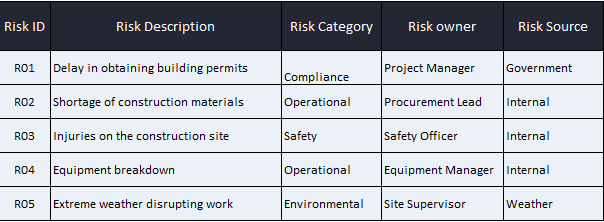
Stakeholder Analysis
Stakeholder analysis maps individuals and groups affected by or influencing the project. Identify their interests, influence level and preferred communication methods. Understanding stakeholders helps you anticipate concerns, gain support and reduce resistance.
Incorporating a stakeholder engagement plan into the proposal timeline ensures the right people are involved at the right times, helping maintain momentum and alignment throughout the project lifecycle.
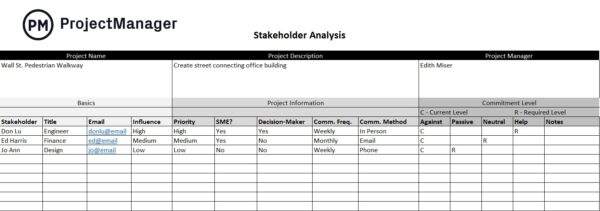
Success Criteria
Success criteria define how project outcomes will be measured and evaluated. Establish clear, measurable indicators that align with objectives and stakeholder expectations. Include both quantitative and qualitative measures to capture impact.
By setting success criteria in advance and tying them to the proposal timeline, you ensure that progress can be monitored effectively and that the project’s value is demonstrated after delivery.
Identification of Proposal Recipients
Identifying proposal recipients ensures your project proposal reaches the right decision-makers and influencers within the organization. This step focuses on understanding who will review, approve or be affected by the proposal.
By targeting the appropriate individuals or groups, you increase the likelihood of a timely and favorable response. A clear understanding of recipients also allows you to tailor the proposal’s content, tone and emphasis to address their priorities and concerns, making your case more compelling and relevant.
- Project Management Office (PMO): The PMO evaluates proposals to ensure alignment with organizational strategy, resource availability, and portfolio balance. It typically oversees the prioritization and governance of projects, helping to standardize processes and guide projects through stage gates. Proposals sent here are reviewed for strategic fit, feasibility and adherence to internal methodologies.
- Executive Leadership Team: This group includes C-level executives or directors who approve high-impact or high-cost proposals. They assess proposals in terms of ROI, risk exposure, and strategic alignment with corporate goals. Their role is to authorize funding and provide high-level oversight, especially for enterprise-wide or cross-departmental initiatives.
- Department Heads or Functional Managers: Project proposals affecting a specific department are often submitted to the relevant functional lead. They evaluate operational impact, resource needs and potential disruptions. If the proposal falls within their domain, they may approve or escalate it and often serve as project sponsors.
- Steering Committee or Governance Board: A formal decision-making body made up of stakeholders from various departments. This committee reviews complex or strategic proposals and ensures that selected projects support business objectives, comply with governance standards, and do not duplicate existing efforts. They also resolve conflicts in prioritization.
- Finance Department: The finance team reviews proposals to verify cost estimates, funding sources, and budget impact. They ensure the project’s financial assumptions are sound, benefits are realistic and risks are mitigated. Their analysis supports decision-makers in determining whether the project is economically feasible and fundable.
5. Proposal Submission
Proposal submission is the stage where the finalized project proposal is formally delivered to the identified recipients. This may involve email distribution, internal document management systems or scheduled presentation meetings.
Ensuring that all required attachments, supporting documents and approvals are included increases the likelihood of a smooth review process. Timely submission according to the proposal timeline demonstrates professionalism and helps maintain momentum toward evaluation and decision-making.
6. Proposal Evaluation
During proposal evaluation, recipients review the document against organizational priorities, feasibility, resource availability and expected benefits. Decision-makers may ask questions, request clarifications or conduct additional analysis to validate assumptions.
This stage ensures that the proposal is thoroughly vetted before committing resources. A structured evaluation process aligned with the proposal timeline helps maintain transparency and allows stakeholders to make informed decisions efficiently.
7. Proposal Approval or Denial
After evaluation, the proposal is either approved, denied or returned for revision. Approval confirms that resources, budget and authority are allocated to move the initiative forward. Denial or requests for revision provide feedback that can be used to refine the proposal or reconsider priorities. Documenting the decision ensures all stakeholders understand the outcome and next steps, keeping the proposal timeline accurate and actionable.
8. Transition to Project Initiation Phase
Once a project proposal is approved, the organization transitions to the project initiation phase. This involves formal planning, resource allocation, kickoff meetings and scheduling. The approved proposal serves as the blueprint for execution, guiding teams on objectives, scope and priorities.
Integrating the proposal timeline into project initiation ensures that momentum is maintained, responsibilities are clear and the project starts on a solid foundation aligned with organizational goals.
Proposal Timeline Template
Download this free proposal timeline template for planning and tracking the stages of a project proposal. It outlines key milestones, deadlines and responsibilities from drafting to submission and approval.
Using a template ensures that all necessary steps are included, helps teams stay organized and allows stakeholders to see the overall schedule at a glance. This structure reduces the risk of missed tasks or delays and supports a smoother internal review process.
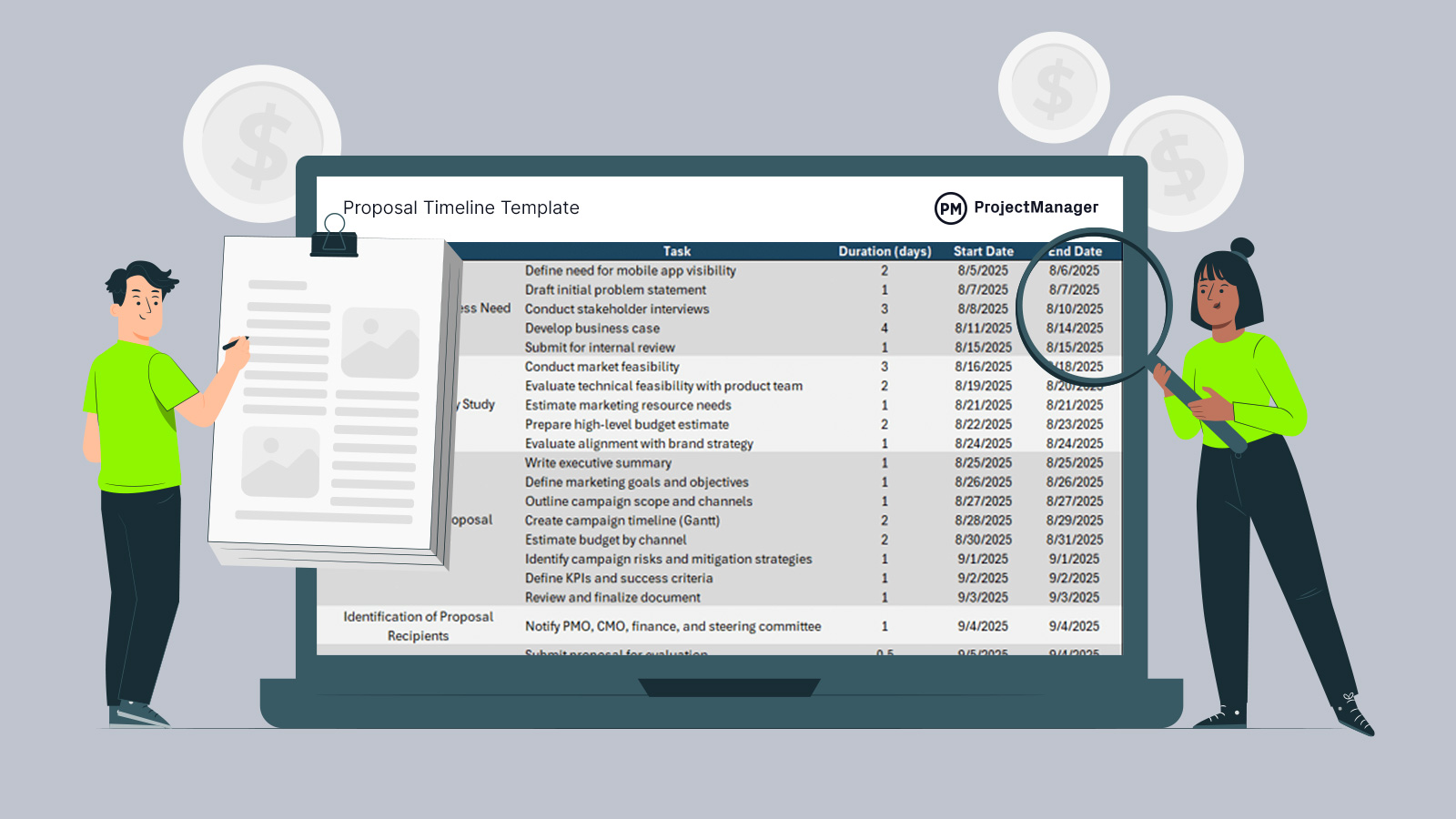
Get your free
Proposal Timeline Template
Use this free Proposal Timeline Template to manage your projects better.
By using a template, teams can standardize the way proposals are managed internally, improve coordination, and maintain consistency across multiple projects while keeping the process efficient and transparent.
Project Proposal Timeline Example
The table below illustrates a detailed project proposal timeline for a marketing initiative to launch a mobile app. It outlines each phase of the proposal process, from identifying the business need to preparing for project kickoff. Every task is mapped with estimated durations and scheduled start and end dates to reflect a realistic 4–5 week planning cycle.
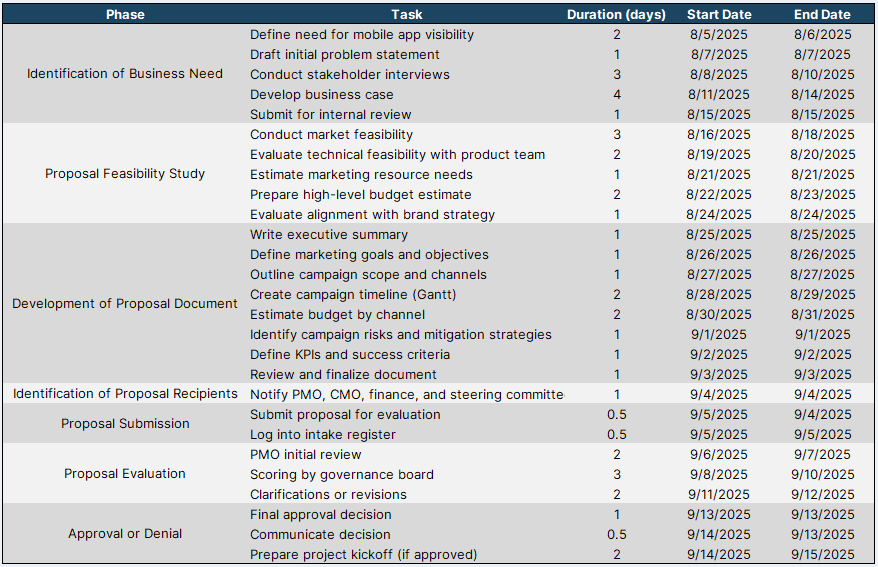
This example follows standard project management practices, including feasibility analysis, stakeholder engagement, proposal development and multi-level review. It highlights how structured planning and coordination across teams (e.g., marketing, finance, PMO) are essential for securing proposal approval and ensuring smooth project initiation.
Use this timeline as a reference when planning your proposals, particularly for time-sensitive or cross-functional marketing initiatives.
Related Project Management Templates
There are more than just a project proposal timeline template available for free download from our site. We have over 100 free project management templates for Excel and Word that cover all aspects of managing projects. Here are just a few that relate to proposal timelines.
Request for Proposal Template
Download this free request for proposal template to solicit detailed bids from vendors or service providers. It outlines the project requirements, objectives, scope, deadlines and evaluation criteria to ensure responses are consistent and comparable. Using a template provides a clear framework for reviewing proposals and making informed decisions about which vendor can best meet the organization’s needs
Project Proposal Template
Use this free project proposal template to organize and present the details of a proposed project. It includes sections for project objectives, scope, timeline, resources, budget, risks and success criteria. It also streamlines the proposal creation process, saving time and improving communication across teams.
Request for Information Template
This free request for information template ist used to gather specific details from vendors, contractors or internal teams. It outlines the information needed, submission deadlines and contact details, ensuring that responses are clear, complete and comparable. Using a template provides a consistent format for tracking and reviewing responses, making it easier to make informed decisions based on the collected information.
How ProjectManager Helps Turn Proposals Into Successful Projects
ProjectManager turns proposals into successful projects by going beyond static templates with live tracking that keeps plans honest. Real-time dashboards, automated alerts, customizable reports, and a built-in RAID log surface risks and issues early so teams can course correct before deadlines slip or budgets drift.
Visualize Work Across Views
Switch between kanban boards, task lists, calendars and portfolio summaries while all data stays in sync. Teams capture ideas on cards, manage approvals in simple lists, and align dates on a shared calendar. Executives scan portfolio health in one place, while contributors focus on their tasks without losing the big picture.
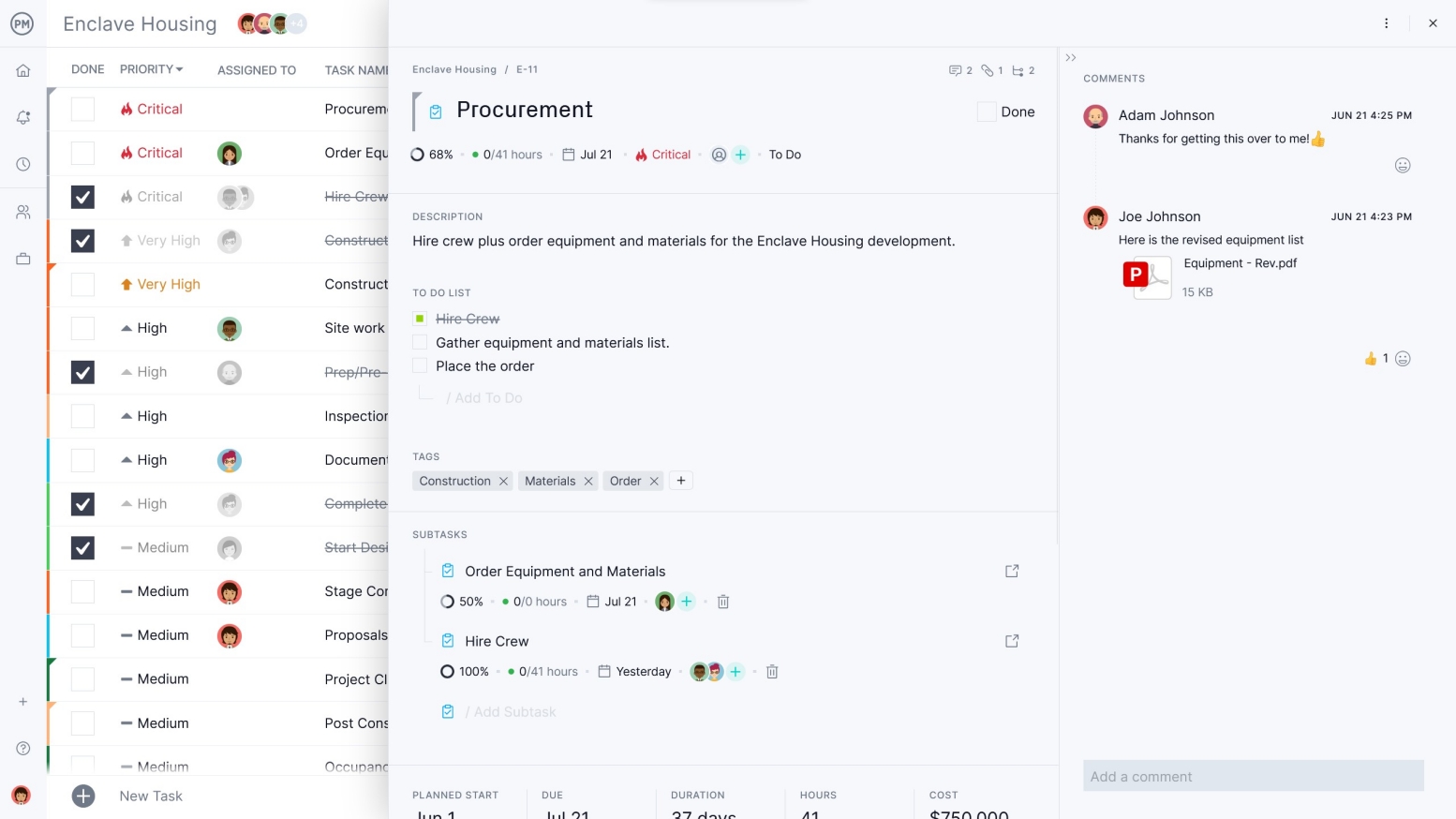
Balance Resources With Clarity
See who is available, who is overallocated and where gaps exist using color-coded workload charts and team pages. Drag to reassign work, set capacity limits, and spot conflicts fast. Availability snapshots make staffing decisions straightforward, so the right people tackle the right tasks at the right time.
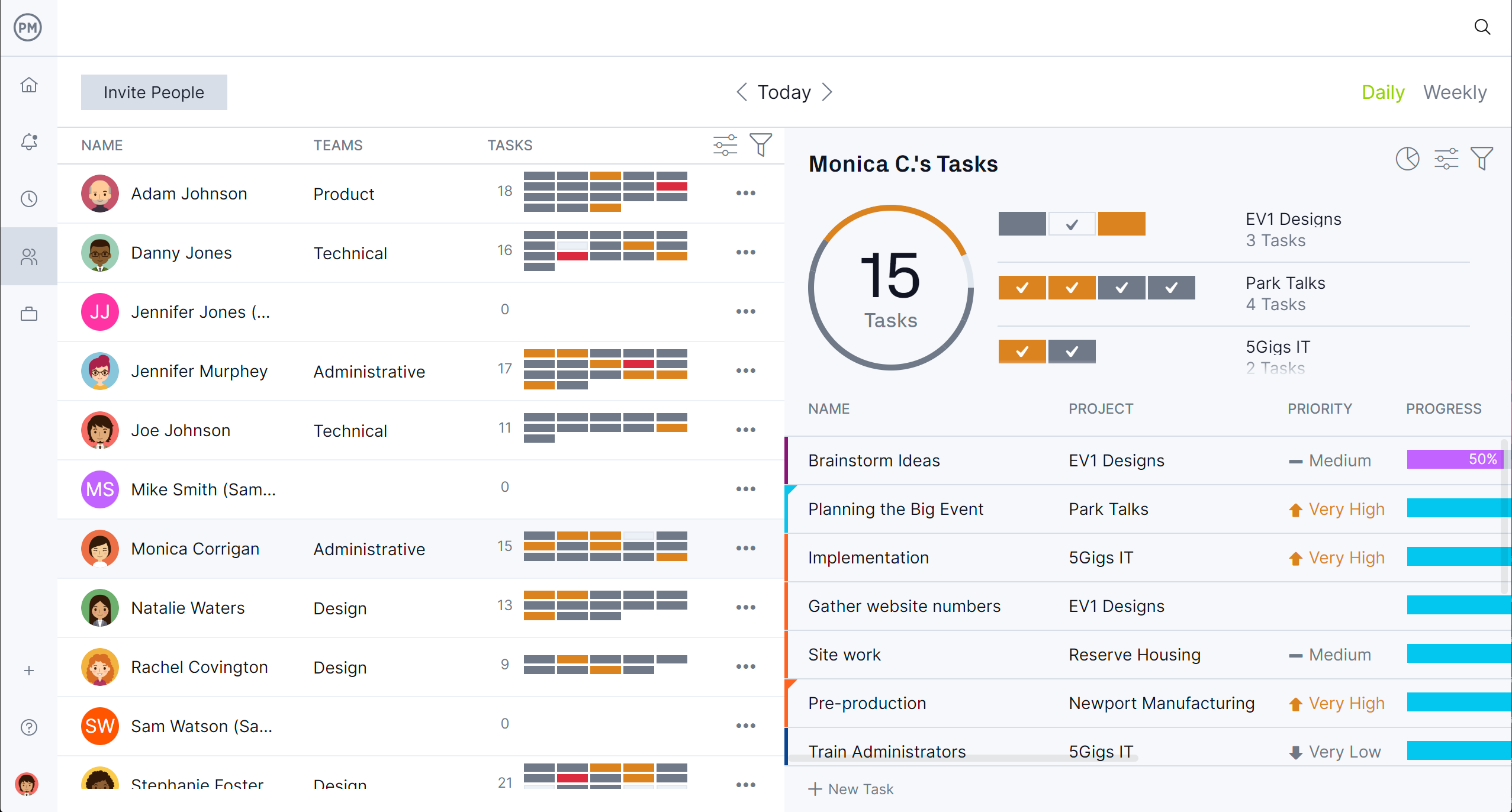
Related Project Management Content
There’s more to a project proposal timeline than we’ve covered here. For those who want to take a deeper dive, follow the links below to a project timeline guide, a how-to blog on writing a project proposal and more.
- Project Timeline Guide with Examples
- How to Write a Project Proposal (Examples & Template Included)
- 12 Free Proposal Templates for Submitting Proposals
ProjectManager is award-winning project and portfolio management software that connects teams whether they’re in the office or out in the field. They can share files, comment at the task level and stay updated with email and in-app notifications. Join teams at Avis, Nestle and Siemens who are using our software to deliver successful projects. Get started with ProjectManager today for free.

